![]()
![]()
![]()
Use LEFT and RIGHT arrow keys to navigate between flashcards;
Use UP and DOWN arrow keys to flip the card;
H to show hint;
A reads text to speech;
17 Cards in this Set
- Front
- Back
|
What is bone?
|
- Metabolic tissue - constantly remodelling
• acts as a mineral buffer for Ca and Mg • needs to be able to repair damage and maintain integrity e.g. microfractures • Quality of bone • coordination between bone cells (osteoblast and osteoclasts) vital - Strength and flexibility • protective and load bearing • balance between being brittle or too bendy |
|
|
Describe the normal composition of bone
|
- Osteoid (~25% bone):
• protein matrix of bone (secreted by osteoblasts) • 90% type 1 collagen • non-collagenous proteins → glycoproteins, → proteoglycans • Resilience and flexibility • Rigidity - Hydroxyapatite (~65% of bone): • mineral component = Ca10(PO4)6(OH)2 |
|
|
Describe the gross structure of bones
|
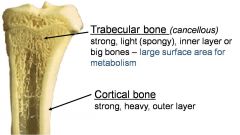
|
|
|
What is the difference between woven and lamellar bone?
|
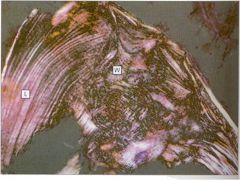
- Woven = weak bone
• Rapid osteoid production • Collagen haphazard • Poor quality • Produced when lamellar bone requires remodelling - Lamellar bone = strong • Highly structured and organised = reinforced concrete • Parallel collagen sheets |
|
|
Why are bones remodelled and how does it occur?
|
1. structural maintenance
2. buffers and releases minerals that are required for other functions in the body - coordination between bone cells (osteoblasts and osteoclasts) vital - complete cycle takes 90 - 200 days |
|
|
What are the 3 types of bone cells?
|
1. Osteoblasts (make bone)
- produce matrix components and mineralise osteoid - when inactive form flat bone lining cells - operate in groups (100’s) 2. Osteoclasts (reabsorb bone) - multinucleated cells from bone marrow lineage - act alone or in pairs/small groups - attachment to bone surface is important 3. Osteocytes (? function ) - old osteoblasts trapped in the bone? - or do they arise separately? - possible mechanoreceptors - transfer mineral to surface |
|
|
Describe 3 ways in which bone structure can be disrupted
|
1. Change in activity
- Overactive/underactive osteoblasts or osteoclasts (turnover) - E.g. renal osteodystrophy / hyperparathyroidism 2. Quantity of bone - too little bone e.g. Osteoporosis (also change in bone turnover rate) - too much bone e.g osteopetrosis, Paget’s Disease (also structure as poor quality) 3. Change in structure - osteogenesis imperfecta - tumours - defective (or loss) mineralisation (lack of Ca2+ / PO4) e.g. rickets/osteomalacia |
|
|
Describe 4 ways that bone structure can be assessed
|
Need to assess quality (strength), quantity (BMD/BMC) and turnover
1. Biochemical measurements - Ca homeostasis (Ca2+/PO4, vit D, PTH, urinary Ca2+) - Bone turnover (alkaline phosphatase & osteocalcin (= increased osteoblastic activity, indicating increased rate of turnover), collagen breakdown/formation) 2. Imaging - plain X-ray - radionucleotide scans (technetium, Tc) = bisphosphate taken up into active sites of bone remodelling - MRI/CT/ultrasound 3. Bone biopsy - histology - Not routine as painful and rarely changes management of a disorder 4. Bone density (BMC vs BMD) - DEXA (Dual Energy X-Ray Absorptiometry) = osteoporosis |
|
|
What are osteochondrodysplasias?
|
Group of conditions among the skeletal dysplasias affecting collagen function. Each characterised by abnormal growth or development. Osteogenesis imperfecta (OI) is one of these
|
|
|
What is osteogenesis imperfecta?
- Types? - Implications |
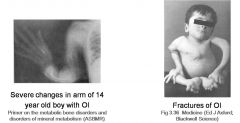
- Defective production of type I collagen
- Genetic (family history in most cases, 25% new mutation) - Clinical severity varies (everything with collagen in it may be affected) - Brittle bones (→ fractures) as loses resilience and flexibility - May have hearing loss (squashes cranial nerves) - Sclera (whites of eyes) may have blue, purple or grey tint - Often problems with teeth (dentinogenesis imperfecta, brownish teeth) - Types: ◘ type I (most common) • Normal collagen but underproduction (all other types have abnormal collagen) → but has same presentation as other types • normal stature • blue sclera • 1:30,000 ◘ type II - lethal in perinatal period • 1:60,000 ◘ type III • progressively deforming bones • teeth problems common • very short stature • deformity at birth • 1:70,000 ◘ type IV • mild to moderate deformity • short stature • teeth problems common • Extremely rare - Implications of brittle bones = multiple fractures → potential confuction with battered baby |
|
|
Describe the symptoms, signs and pathophysiology of Paget's Disease
|

- 2nd most common bone disease: 1 million sufferers in UK
(prevalence 1.5-8%, 1 in 10 > 80, more males than females) - Rare < 25 years old, generally > 40 - Significant genetic component - Symptoms/signs/complications • Very variable • May be none • fractures • pain (bone or pressure on nearby nerves) • deformity (bowing, increased skull size (increased in hat size common first symptoms. Skull can be 1.5 in thick), spinal curvature) • arthritis • deafness/disturbed vision • cardiac, neurological and neoplastic complications - Localised defects = often doesn't spread beyond original affected area (common site femur, spine, skull and tibia) - Pathology: • increased osteoclastic activity (increased numbers/ increased nuclei) • compensatory increase in osteoblastic activity - new bone! • Bone formed = woven, so very hard but poor quality → disorganised → expanded in size → less compact → more vascular → weaker - more susceptible to fracture/deformity = bowing which is more likely to fracture when carrying same forces |
|
|
Give 3 bone conditions linked to calcium homeostasis and vitamin D
|
1. Hyperparathyroidism
2. Renal osteodystrophy / renal bone disorders 3. Rickets / osteomalacia |
|
|
What is rickets and osteomalacia and describe the pathology behind them?
|

- Inadequate mineralisation of bone = normal collagen but abnormal mineral
- Children (rickets) • Failure or delay to mineralise endochondral bone in GP • growth plate is elongated and calcification delayed • Weight bearing produces a bowing deformity of weight bearing limbs (sometimes other bone defects due to soft bones) • Increased fractures • Defects in teeth/enamel • Muscle weakness • Bone pain - Adults (osteomalacia) • Failure to mineralise newly formed osteoid • Increased osteoid width and delayed mineralisation - Can be caused by: • Defect in vitamin D availability or metabolism (most common) • Calcium deficiency = affects osteoblast and osteoclast and chrondocyte functions → Intake → Absorption (vitamin D) • Phosphate availability = rarer and usually has other more serious symptoms • X-linked hypophosphataemic rickets → rare and genetic → abnormal alkaline phosphatase - Pathology: Vitamin D required for: • osteoblast and osteoclast differentiation • cartilage production (chondrocytes) • mineralisation (? indirect) • Increases osteoclast action (direct on bone) but via osteoblasts • Ca2+ absorption from gut - Deficiency in vitamin D caused by • dietary/sunlight • inherited (very rare) • enzyme defect (vitamin D resistant rickets type I) • VDR defect e.g. → pseudovitamin D resistant rickets (PDDR) → vitamin D resistant rickets type II (VDDR II) hereditary → vitamin D resistant rickets (HVDRR) |
|
|
Describe osteoporosis:
1. Epidemiology 2. Diagnosis 3. Common causes 4. Bone defects 5. Signs and symptoms |
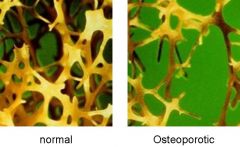
1. Epidemiology:
- 1 in 2 women and 1 in 5 men > 50 years old have osteoporosis - 3 million people in the UK - Every three minutes someone has a fracture = 70,000 hip, 50,000 wrist, 40,000 spinal fractures - Hip fractures (UK) cause as many deaths as breast cancer - Men experience more osteoporotic fractures than prostate cancer 2. Diagnosis - It is the degree of osteoporosis that is important – how much bone do you lose - WHO definition (based on T score): BMD >2.5SD below the population mean for young adults - 1 or below = normal - 1-2.5 = osteopnea - T-score is the number of standard deviations below the average for a young adult at peak bone density. - Diagnosis based on a DEXA scan → blue is poor density, red is high density - Remember some bone loss is normal 3. Common causes: - Post-menopausal oestrogen loss → usually develop 5 years earlier in females - Steroid treatment (Cushings syndrome/disease) - Pregnancy/breast feeding (less common & reversible - Hypogonadism (male and female) - Transplantation (immunosuppressive drugs) - Lack of activity (low weight e.g. in dancers) - Vitamin D and Ca2+ deficiency = not a caused by associated with it and can make worse 4. Bone defects: - Increased bone turnover - Osteoclasts make deeper holes - Osteoblasts not as efficient - Not just the loss of bone, but also the change in structure that is important as structure of the bone conveys the strength 5. Signs and symptoms - Often the first sign of osteoporosis is a fracture • wrist or hip (slips and falls) • spine → pain → kyphosis |
|
|
Describe the types of tumours that can occur in bones and the lesions that they may produce
|
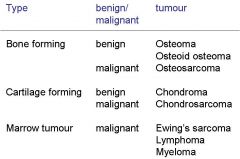
- Primary tumours rare (generally occur in young)
- Secondary tumours common esp from lung, breast, prostate, thyroid, kidney, multiple myeloma = 3rd most common site metastases after lung and liver - Primary tumours often involve joints - Painful = multiple myeloma. Osteoclastic activity → bone pain which is often the presenting symptom - Often only symptomatic treatment offered - May occur in bone or in the bone marrow - Lesions may be: • Growth lesions = 'blastic' lesions which forms a dense mass of very thick bones due to wrong signalling • Osteoloytic lesions = mass in which the bone has dissolved due to overactive osteoclasts or too many - Type of lesion develops on which cell type proliferates: • i.e. growth OB • resorption OC - most common (hypercalcaemia and fracture → PAIN) |
|
|
Why are teeth important to consider when thinking about bone disease?
|
- Teeth are embedded in bone
- Composed of hydroxyapatite - Minerals constantly deposited - Contain osteoblast and osteoclast like cells - If there is a problem in the bone, the chances are there will also be a problem in the teeth |
|
|
Describe the role of bone in normal calcium homeostasis
|
- Normal calcium homeostasis is maintained by interactions between bones, the parathyroid glands, the kidneys and the gut.
- The regulation of calcium release from or deposition in bones is an important regulator of plasma calcium concentration. - Although calcium is vital for normal bone structure it is also important to remember that it has a number of physiological roles, including muscle contraction, enzyme co-factor, second messenger and stabilisation of membrane potentials. - Consequently a disruption of normal calcium homeostasis results in a number of clinical conditions including: i) Hypocalcaemia, which can cause neuromuscular irritability, muscle cramps/tetany, seizures and an altered ECG. i) Hypercalcaemia, which can present with mild, variable symptoms, but can cause renal stones and an altered ECG. ii) Bone and tooth disorders. |

